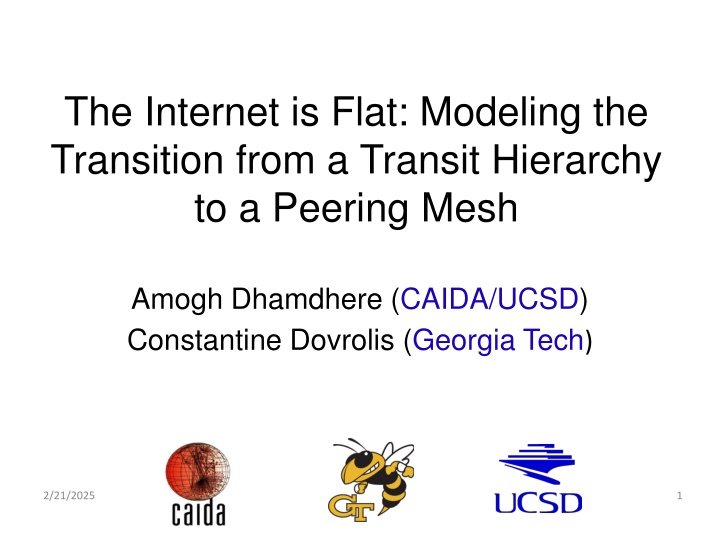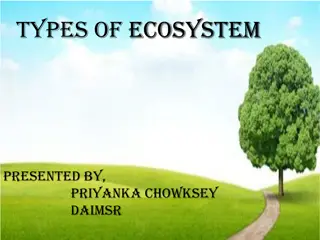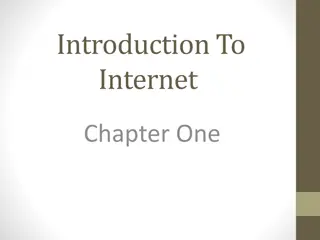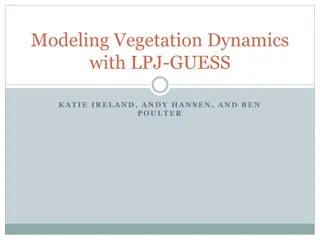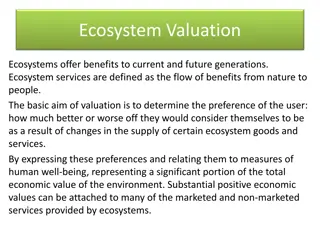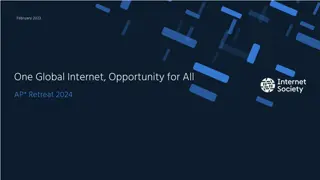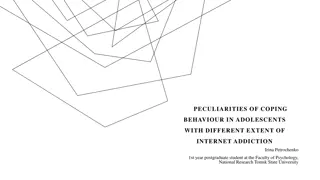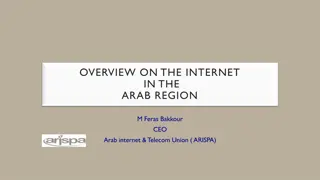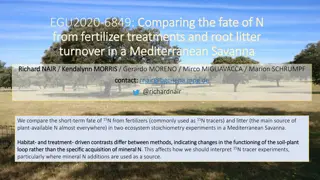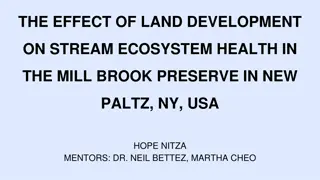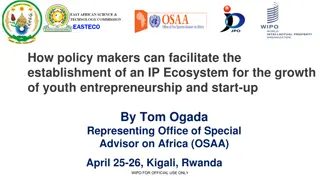Modeling the Internet Ecosystem Transition
Delve into the evolution of the Internet from a transit hierarchy to a peering mesh, exploring the economics, recent trends, and previous research. Discover how agent-based computational models like ITER shed light on Internet evolution questions.
Download Presentation

Please find below an Image/Link to download the presentation.
The content on the website is provided AS IS for your information and personal use only. It may not be sold, licensed, or shared on other websites without obtaining consent from the author.If you encounter any issues during the download, it is possible that the publisher has removed the file from their server.
You are allowed to download the files provided on this website for personal or commercial use, subject to the condition that they are used lawfully. All files are the property of their respective owners.
The content on the website is provided AS IS for your information and personal use only. It may not be sold, licensed, or shared on other websites without obtaining consent from the author.
E N D
Presentation Transcript
The Internet is Flat: Modeling the Transition from a Transit Hierarchy to a Peering Mesh Amogh Dhamdhere (CAIDA/UCSD) Constantine Dovrolis (Georgia Tech) 2/21/2025 1
The Internet Ecosystem More than 30,000 autonomous networks independently operated and managed The Internet Ecosystem Different types of networks Interact with each other and with environment Network interactions Localized, in the form of bilateral contracts Customer-provider or settlement-free peering Distributed optimizations by each network 2/21/2025 The Internet is Flat CoNEXT 2010 2
Economics of the Internet Ecosystem Traffic growth Source: Cisco Transit price decline Source: William Norton Ad revenue increase Source: IAB Content Consolidation Source: Arbor Networks 2/21/2025 The Internet is Flat CoNEXT 2010 3
Recent Trends: Arbor Networks Study The Old Internet (late 90s 2007) Top content providers generated small fraction of total traffic Content providers were mostly local Peering was restrictive The New Internet (2007 onwards) Top content providers generate large fraction of total traffic Content providers are present everywhere Peering is more open How do the old and new Internet differ in terms of topology, traffic flow, and economics? Internet Interdomain Traffic , Labovitz et al., Sigcomm 2010 2/21/2025 The Internet is Flat CoNEXT 2010 4
Previous Work Descriptive Match graph properties e.g. degree distribution Homogeneity Nodes and links all the same Game theoretic, analytical Restrictive assumptions Little relation to real- world data Bottom-up Model the actions of individual networks Heterogeneity Networks with different incentives, link types Computational As much realism as possible Parameterize/validate using real data 2/21/2025 The Internet is Flat CoNEXT 2010 5
The ITER Model Agent-based computational model to answer what-if questions about Internet evolution Inputs Network types based on business function Pricing/cost parameters Interdomain traffic matrix Geographical constraints Peer/provider selection methods Output: Equilibrium internetwork topology, traffic flow, per-network fitness 2/21/2025 The Internet is Flat CoNEXT 2010 6
ITER: Model Components Enterprise Customers (EC) e.g., Georgia Tech Small (regional) Transit Providers (STP) e.g., France Telecom Large (tier-1) Transit Providers (LTP) e.g., AT&T Content Providers (CP) e.g., Google Transit, peering and operational costs based on data from NANOG and network operators Traffic matrix based on studies of content popularity, Arbor study, measurements at GT Geographical presence modeled as presence at IXPs 2/21/2025 The Internet is Flat CoNEXT 2010 7
ITER: Provider and Peer Selection Provider selection Choose providers based on customer cone size Measure of the size of a provider Used by commercial products, e.g., Renesys Peer selection Peer if ratio of total traffic handled is less than Approximates the equality of two ISPs 2/21/2025 The Internet is Flat CoNEXT 2010 8
The ITER approach Routing Cost/price parameters Interdomain TM Interdomain topology Traffic flow Per-AS economic fitness Provider AS selection Optimizations Peer selection Analytically intractable! Find equilibrium Equilibrium: no network has the incentive to change its providers/peers computationally, using agent-based simulations 2/21/2025 The Internet is Flat CoNEXT 2010 9
Properties of the equilibrium Is an equilibrium reached? Yes, in most cases Is the equilibrium unique? No, can depend on playing sequence Multiple runs with different playing sequence Per-network properties vary widely across runs Macroscopic properties show low variability 2/21/2025 The Internet is Flat CoNEXT 2010 10
ITER: Simulating the old and new Internet Same initial topology: constructed with a full- mesh of LTP peering links, preferential attachment to connect ECs and CPs Change three parameters Fraction of traffic sourced by CPs (10% vs. 60%) Geographical spread of CPs (one region vs. all regions) Peering traffic threshold ( =1 vs. =10) 50 simulation runs for each instance, average results across runs 2/21/2025 The Internet is Flat CoNEXT 2010 11
ITER Sims: End-to-end Paths End-to-end paths weighted by traffic are shorter in the new Internet Paths carrying the most traffic are shorter AS path lengths Weighted AS path lengths 2/21/2025 The Internet is Flat CoNEXT 2010 12
ITER Sims: Traffic Transiting Transit Providers Traffic bypasses transit providers More traffic flows directly on peering links Implication: Transit providers lose money! Content providers get richer Traffic transiting LTPs Traffic transiting STPs 2/21/2025 The Internet is Flat CoNEXT 2010 13
ITER Sims: Traffic Over Unprofitable Providers More transit providers are unprofitable in the new Internet These unprofitable providers still have to carry traffic! Possibility of mergers, bankruptcies or acquisitions Traffic transiting unprofitable providers 2/21/2025 The Internet is Flat CoNEXT 2010 14
ITER Sims: Peering in the New Internet Transit providers need to peer strategically in the new Internet STPs peering with CPs: saves transit costs LTPs peering with CPs: attracts traffic that would have bypassed them 2/21/2025 The Internet is Flat CoNEXT 2010 15
Three Factors Vary only one of the three factors (fraction of CP traffic) metrics to the values in the new Internet All three factors need to change to see the differences between the old and new Internet changed One factor by itself cannot change output Weighted path length Values in the new Internet when all three parameters are Traffic transiting STPs Traffic transiting LTPs 2/21/2025 The Internet is Flat CoNEXT 2010 16
Summary ITER: A computational, agent-based model of interdomain network formation Captures the interactions between topology, routing, economics and interdomain traffic flow Compared old and new Internet in terms of topology, traffic flow, per-network profitability 2/21/2025 The Internet is Flat CoNEXT 2010 17
Thanks! Questions? amogh@caida.org www.caida.org/~amogh We gratefully acknowledge funding from the NSF and Cisco Systems 2/21/2025 The Internet is Flat CoNEXT 2010 18
Backup slides 2/21/2025 The Internet is Flat CoNEXT 2010 19
Dependence on Initial Conditions LTPs that are profitable eventually are also profitable initially in both old and new Internet Old Internet: 75% of the eventually fit STPs are fit in the initial topology New Internet: 50% of the eventually fit STPs are fit in the initial topology STPs that transition from unprofitable to profitable in the new Internet: peer strategically with large CPs 2/21/2025 The Internet is Flat CoNEXT 2010 20
Economics of the Internet Ecosystem How do we make sense of all this? 2/21/2025 The Internet is Flat CoNEXT 2010 21
Economically-principled models Objective: Understand the structure and dynamics of the Internet ecosystem from an economic perspective Capture interactions between interdomain topology, routing, economics, and resulting interdomain traffic flow Create a scientific basis for modeling Internet interconnection and dynamics based on empirical data 2/21/2025 The Internet is Flat CoNEXT 2010 22
High Level Questions How does the Internet ecosystem evolve? What is the Internet heading towards? Topology Economics Performance Which interconnection strategies of networks optimize their profits, costs and performance? How do these strategies affect the global Internet? 2/21/2025 The Internet is Flat CoNEXT 2010 23
Why Study Equilibria? The Internet is never at equilibrium, right? Networks come and go, traffic patterns change, pricing/cost structures change, etc . Studying equilibria tells us what s the best that networks could do under certain traffic/economic conditions, and what that means for the Internet as a whole If those conditions change, we need to re- compute equilibria 2/21/2025 The Internet is Flat CoNEXT 2010 24
ITER: Network Types Enterprise Customers (EC) Stub networks at the edge, e.g. Georgia Tech Transit Providers Provide Internet transit Regional in scope (STP), e.g. Comcast Tier-1 or global (LTP), e.g., AT&T Content Providers (CP) Major sources of content, e.g. Google 2/21/2025 The Internet is Flat CoNEXT 2010 25
Network actions Networks perform their actions sequentially Can observe the actions of previous networks And the effects of those actions on traffic flow and economics Network actions in each move Pick set of preferred providers Evaluate each existing peering link Try to create new peering links 2/21/2025 The Internet is Flat CoNEXT 2010 26
Computing Equilibrium Situation where no network has the incentive to change its connectivity Too complex to find analytically: Solve computationally Computation Proceeds iteratively, networks play in sequence Compute routing, traffic flow, AS fitness Repeat until no player has incentive to move 2/21/2025 The Internet is Flat CoNEXT 2010 27
Validation Validation of a model that involves traffic, topology, economics and network actions is hard! Best-effort parameterization and validation Parameterized transit, peering and operational costs, traffic matrix properties, geographical spread using best available data 2/21/2025 The Internet is Flat CoNEXT 2010 28
Validation ITER produces networks with heavy- tailed degree distribution 2/21/2025 The Internet is Flat CoNEXT 2010 29
Validation ITER produces networks with a heavy- tailed distribution of link loads 2/21/2025 The Internet is Flat CoNEXT 2010 30
Validation Average path lengths stay almost constant as the network size is increased 2/21/2025 The Internet is Flat CoNEXT 2010 31
STPs Peering with CPs LTP $$ $$ CP STP Peering with CPs saves transit costs for STPs 2/21/2025 The Internet is Flat CoNEXT 2010 32
LTPs Peering with CPs LTP CP $$ CP STP Peering with CPs attracts traffic (revenue) for LTPs 2/21/2025 The Internet is Flat CoNEXT 2010 33
What-if scenario: A super-CP What if a single CP sources a large fraction of the total traffic? ITER sims: STPs see higher fitness, LTPs see lower fitness For STPs: lower peering costs, larger transit savings by peering with a single CP For LTPs: lower peering costs, but more traffic bypasses them 2/21/2025 The Internet is Flat CoNEXT 2010 34
Peering Policies What peering policies do networks use? How does this depend on network type? Do they peer at IXPs? How many IXPs are they present at? PeeringDB: Public database where ISPs volunteer information about business type, traffic volumes, peering policies Collecting peeringDB snapshots periodically Goal is to study how peering policies evolve 2/21/2025 The Internet is Flat CoNEXT 2010 35
peeringDB 2/21/2025 The Internet is Flat CoNEXT 2010 36
